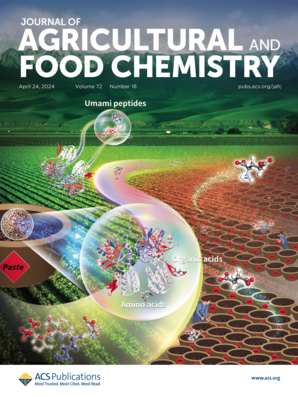白术AlTPS6是根结线虫侵染的重要调控靶点。
IF 6.2
1区 农林科学
Q1 AGRICULTURE, MULTIDISCIPLINARY
引用次数: 0
摘要
根结线虫(RKNs)是一种广泛存在的寄生虫,它通过削弱植物的免疫系统来损害作物,导致根系溃烂和生长迟缓。然而,RKNs如何调节寄主植物防御的分子机制仍然很大程度上未知。药用植物苍术经常遭受rkn的损失。我们利用组织学、转录组学和代谢组学评估,研究了弓形裂丝单倍体感染前和感染后棘球蚴的变化。受感染的根表现出组织和巨细胞形成受损,精油和四种典型生物活性成分(β-苦参酚、黄芪醇、苍术素和苍术素)显著减少。转录组学分析显示,与细胞壁、MAPK通路、热休克蛋白、过氧化物酶、泛素蛋白酶、TFs、TPS和激素相关的基因表达发生了显著变化。AlTPS6基因是产生β-石竹烯的主要基因,在低浓度下具有很强的吸引力,在高浓度下具有很强的杀线虫活性。综上所述,M. hapla通过操纵宿主MAPK信号和相关基因来下调AlTPS6的表达,从而成功地感染和繁殖。我们的研究结果拓宽了我们对RKNs与宿主之间相互作用和调控的认识。本文章由计算机程序翻译,如有差异,请以英文原文为准。
AlTPS6 from Atractylodes lancea Is a Crucial Regulatory Target for Root-Knot Nematode Infestation.
Root-knot nematodes (RKNs) are widespread parasites that damage crops by weakening the plant immune system, causing root galls and stunting growth. However, the molecular mechanisms behind how RKNs regulate host plant defenses remain largely unknown. The medicinal plant Atractylodes lancea frequently suffers losses from RKNs. We investigated the alterations in A. lancea pre- and postinfection by Meloidogyne hapla utilizing histological, transcriptomic, and metabolomic assessment. Infected roots exhibited compromised tissue and giant cell formation as well as a notable reduction of essential oils and four typical bioactive components, i.e., β-eudesmol, hinesol, atractylon, and atractylodin. Transcriptomic analysis revealed significant changes in gene expression related to the cell wall, MAPK pathway, heat shock proteins, peroxidases, ubiquitin proteases, TFs, TPS, and hormones. The AlTPS6 gene was identified as responsible for producing β-caryophyllene, which exhibited strong attraction at low concentrations and nematicidal activity at high concentrations. Taken together, M. hapla downregulated AlTPS6 expression by manipulating host MAPK signaling and related genes to succeed in their infection and reproduction in A. lancea. Our results broaden our insight into the interaction and regulation between RKNs and host.
求助全文
通过发布文献求助,成功后即可免费获取论文全文。
去求助
来源期刊
CiteScore
9.90
自引率
8.20%
发文量
1375
审稿时长
2.3 months
期刊介绍:
The Journal of Agricultural and Food Chemistry publishes high-quality, cutting edge original research representing complete studies and research advances dealing with the chemistry and biochemistry of agriculture and food. The Journal also encourages papers with chemistry and/or biochemistry as a major component combined with biological/sensory/nutritional/toxicological evaluation related to agriculture and/or food.

 求助内容:
求助内容: 应助结果提醒方式:
应助结果提醒方式:


